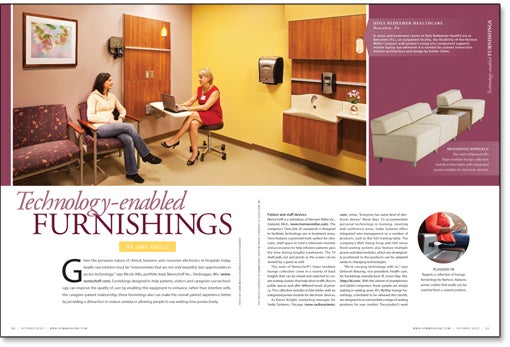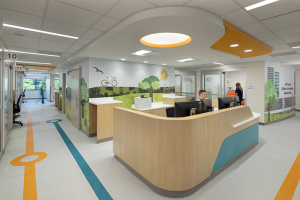Technology-enabled furnishings

Click the above image for a PDF download
Given the pervasive nature of clinical, business and consumer electronics in hospitals today, health care interiors must be "environments that are not only beautiful, but opportunities to access technology," says Nicole Allis, portfolio lead, Nemschoff Inc., Sheboygan, Wis. (www.nemschoff.com). Furnishings designed to help patients, visitors and caregivers use technology can improve the quality of care by enabling this equipment to enhance, rather than interfere with, the caregiver-patient relationship; these furnishings also can make the overall patient experience better by providing a distraction to reduce anxiety or allowing people to use waiting time productively.
Patient and staff devices
Nemschoff is a subsidiary of Herman Miller Inc., Zeeland, Mich. (www.hermanmiller.com). The company's Terra line of casegoods is designed to facilitate technology use in treatment areas. Terra features a powered work surface for clinicians, shelf space to hold a television monitor and accessories to help infusion patients pass the time during lengthy treatments. The TV shelf pulls out and pivots so the screen can be viewed by a guest as well.
The seats of Nemschoff's Steps modular lounge collection come in a variety of back heights that can be mixed and matched to create seating clusters that help direct traffic flow in public spaces and offer different levels of privacy. The collection includes in-line tables with an integrated power module for electronic devices.
As Karen Knight, marketing manager for Sedia Systems, Chicago (www.sediasystems.com), notes, "Everyone has some kind of electronic device" these days. To accommodate personal technology in training, meeting and conference areas, Sedia Systems offers integrated wire management on a number of products, such as the X20 training table. The company's M60 Swing Away and O60 series fixed seating systems also feature multiple power and data modules, which are strategically positioned so the products can be adapted easily to changing technologies.
"We're carrying technology with us," says Deborah Breunig, vice president, health care, for furnishings manufacturer KI, Green Bay, Wis. (http://ki.com). With the advent of smartphones and tablet computers, fewer people are simply waiting in waiting areas. KI's MyWay lounge furnishings, scheduled to be released this month, are designed to accommodate a range of seating positions, for user comfort. The product's work arm can support an electronic device between two people, to allow for interaction. Optional power outlets let users recharge devices.
Flexible furnishings
To enhance teamwork, KI's Backbone Media Platform makes it possible for users to share data among up to six devices on their own screens or a projector. Customers provide the switching hardware, so facilities can choose a preferred technology for simplified in-house support.
KI also offers adjustable-height work surfaces. The Genesis, WorkUp and Toggle products allow users to work from a seated or standing position; the sit/stand option helps to alleviate some of the health risks associated with the sedentary lifestyle that can result from extended computer use. The products' quick adaptability is especially useful in health care environments that operate 24/7, in which several people may share a work surface throughout the day, notes Breunig.
The Compass line of modular casegoods from Herman Miller Healthcare (www.hermanmiller.com/solutions/healthcare.html), a Herman Miller Inc. subsidiary, is highly adaptable also. "Compass is a canvas," says Julie Casper, portfolio lead, product management, Herman Miller Healthcare. "If technology changes, we can change the system." Compass' power and data tiles are easy to replace or reconfigure as needed. Facilities can, for example, add a USB port or move an outlet without the upheaval of cutting into drywall, patching and painting. "They don't have to overdesign with outlets, trying to figure out the future," Casper says. Compass headwalls are not integrated into the building structure, for maximum flexibility in patient room design (and redesign).
The Compass line also is built to adapt to changing clinician preferences in patient care. The product's compact profile provides space for portable medical equipment to be brought into the patient room, and its work surface can be pulled out and rotated 180 degrees to enable a caregiver to enter or discuss data in an electronic health record (EHR) without having to turn his or her back to the patient.
The Relay wall-mounted charting station, Pocket mobile charting cart and Sync centralized and decentralized nurse stations by Steelcase Inc.'s health care unit, Nurture, Grand Rapids, Mich. (www.nurture.com), can function together to provide a holistic solution for electronic charting, according to Robin Polavin, product manager, Nurture. The Relay and Pocket products enable caregivers to access EHRs while maintaining eye contact with patients; Sync provides an adjustable work surface where members of the care team can gather around monitors and share information.
Nurture's Media:scape promotes collaboration by enabling users to share digital content quickly and easily on screens, via a projector or using a third-party, high-definition videoconferencing system. The product line is available in a variety of configurations, including lounge, seated- and standing-height tables.
Regard, a collection of lounge furnishings Nurture plans to make available this winter, includes a media casegood with an integrated flat-screen television monitor to make digital patient education and entertainment material accessible, but unobtrusive, in waiting areas. Regard pieces feature power outlets in multiple locations that can be reached easily from a seated position.
Design evolution
Technological advances are creating new possibilities for how and where physicians and patients can interact, and furnishings are supporting these developments. At the 2013 NeoCon design exposition and conference in Chicago, researchers demonstrated the Smartphone Physical (www.smartphonephysical.org), a concept developed by engineers-turned-medical students Shiv Gaglani and Michael C. Hoaglin that uses smartphone-based devices to collect and record health data. The Smartphone Physical team conducted exams in Nurture's NeoCon showroom, utilizing Regard to create a comfortable, constructive waiting area; Pocket mobile work surfaces for clinician maneuverability; and Nurture's Empath recliner in place of a traditional exam table. The seated position gives patients more dignity and makes them feel less vulnerable than they might lying flat on an exam table, says Hoaglin. This can foster a patient-physician relationship that's more productive than paternalistic.
Polavin says the goal in health care furnishing design is "to understand how people connect in health care." More and more, this connection involves technology. New technologies present new opportunities, he says. "We're always asking, 'What if?' in our design development process. We want the furniture to evolve as quickly as technology."




